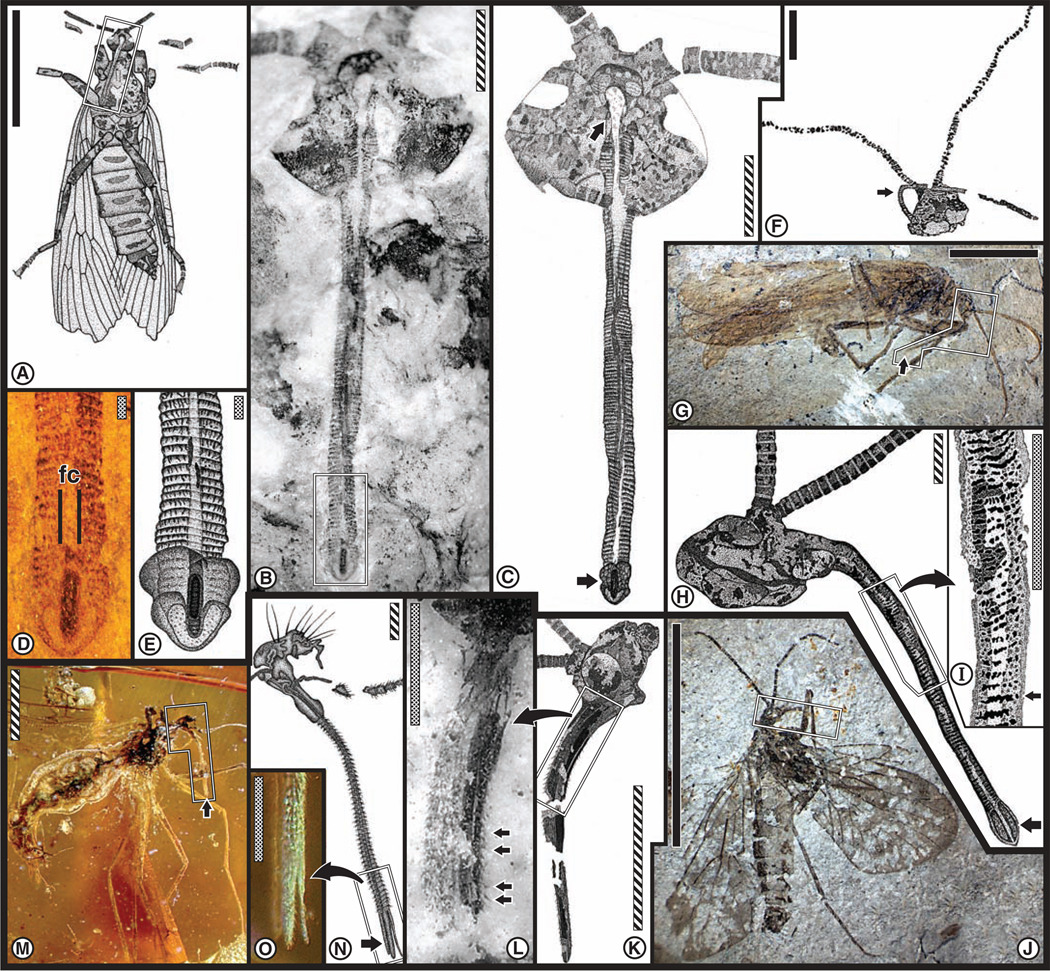Fig. 2.
Head and mouthpart features associated with fluid-feeding in two specimens of siphonate Aneuretopsychidae (A to E and G to I) and in three specimens of siphonate (F and J to L) and stylate (M to O) Pseudopolycentropodidae, scorpionflies from the Middle Jurassic to late Early Cretaceous, from northeastern China and northern Myanmar (Burma). Shown in (A) to (E) is the head and mouthpart structure of Jeholopsyche liaoningensis Ren, Shih & Labandeira gen et sp. nov. (13), illustrating ventral body aspect (A) and dorsal view of head and mouthparts in photo (B) and drawing (C) (CNU-M-LB2005002). Note the filiform antennae, palp absence, compound eyes surrounded by prominent ocular sclerite (ring), and bracketing of a prominent clypeal region housing a cibarial pump. The long siphon has thickened striate walls basally [(B), upper arrow in (C)] and is annulated by small transverse ridges, bearing a food canal (fc) and terminus with a V-shaped pseudolabellum (type 2), elongate-ellipsoidal mouth with opaque contents, and lateral fleshy lobes [lower arrow in (C)] in the photo (D) and drawing (E). A specimen (CNU-M-NN2005003) of Pseudopolycentropus janeannae Ren, Shih & Labandeira sp. nov. (13) in (F), exhibiting a siphon curving 160° without fracture (arrow). (G) Another specimen (CNU-M-LB2005001) of an undetermined palpless species of Jeholopsyche shown in lateral view bearing a proboscis (arrow), probably in life position. (H) Enlargement of head and mouthparts boxed in (G), illustrating a robust proboscis base housing a cibarial pump and a terminus expanded to form a type 3 pseudolabellum (at arrow), homologous to that of (D) and (E). (I) Siphonal area boxed in (H) is enlarged to show segmented transverse ridges and food canal. Shown in (J) to (L) is the small species Pseudopolycentropus janeannae Ren, Shih & Labandeira sp. nov. (13) (CNU-M-NN2005004), illustrated in right lateral view in (J) and left head profile of counterpart in (K). In (K) are broad circular eyes with diminutive ocular sclerite, absence of palps, well defined labrum (base of arrow), an externally smooth, finely pilose, external siphonal surface, and absence of any lobe-like modification of the rounded terminus. Dense, fine setae on the proboscis are enlarged in (L) (arrows). Shown in (M) to (O) is a specimen of Parapolycentropus burmiticus (AMNH-Bu-1444) from Burmese amber. Entire insect (M) bears head and mouthparts, emphasizing stylate mouthparts within a labial tube. (N) Drawing [enlargement of boxed area in (M)] shows robust setae emerging from proboscis annulae and a distinct stylet, the terminus housing separated type 4 pseudolabellae [magnified in (O)]. Scale bars: solid, 10 mm; striped, 1 mm; dotted, 0.1 mm.

